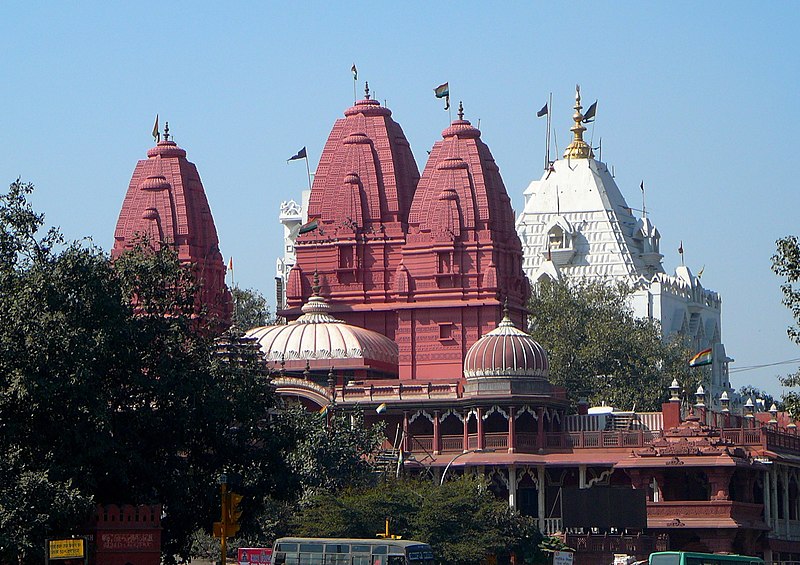Lal Mandir : Delhi’s Oldest Red Temple and Avian Hospital
The Lal Mandir, also known as the Red Temple, is the oldest and most well-known Jain temple in Delhi. It is situated in the Chandni Chowk region, close to the Red Fort, and is constructed entirely from red sandstone. Originally erected in 1658, the temple has since undergone significant modifications and renovations. Dedicated to the 23rd Jain Tirthankara, Parshvanath, the temple contains a large statue of him and also houses idols of Rishabhdev, Lord Mahavir, and other deities.
The temple is renowned for its stunning architecture, intricate carvings, and exquisite gold artwork and frescoes. Additionally, it is well-known for its Jain Birds Hospital, a significant avian veterinary hospital located behind the main temple complex. The hospital embodies the Jain principle of ‘live and let live’ and houses general wards and an ICU, providing top-notch care for birds and avian patients.
The temple celebrates several major festivals, including Paryushan, Samvatsari, Jnaan Panchami, and Deepawali. If you visit during these times, you can be a part of the grand celebrations. Despite being located in the bustling heart of Delhi, the Sri Digambar Jain Lal Mandir offers a serene and spiritual experience for visitors.
History of Lal Mandir
The foundation of old Delhi city is attributed to the Mughal Emperor Shah Jahan. History reveals that he oversaw the construction of a walled city and chose to reside in the Red Fort. Furthermore, he extended an invitation to some Jain merchants to engage in trade in the city and allotted them some land south of the Red Fort area, specifically in the DaribaGali locality. The merchants were permitted to construct a temporary Jain temple in the area, which still stands today. This temple was furnished with three prominent statues of Jain deities, with the most significant being Parshvanath.
In the years between 1800 and 1807, Raja Harsukh Rai made certain alterations to the temple, and a royal shikhara was added to enhance its beauty. This revamped temple came to be known as the “NayaMandir,” which translates to “new temple.”
Architecture of Sri Digambar Jain Lal Mandir
Currently located in front of the main temple complex is the Manastambh, which serves as a pillar of honor. The primary meditation area can be found on the first floor, which can be accessed through a flight of stairs. The temple complex contains not only the major shrines of Parshvanath, Mahavir, and Rishabhdev but also several smaller shrines dedicated to other Jain deities. Within the compound, there is also a memorial dedicated to the revered Digambara Jain monk Acharya Shanti Sagar. Apart from the renowned bird’s hospital, visitors can also find a small bookstore that sells Jain literature and accessories.
Bird’s Charity Hospital
In the temple premises stands a renowned hospital that caters exclusively to birds – the Bird’s Charity Hospital. Established in 1956 under the guidance of Acharya DeshbhushanMaharaj, this hospital has been providing treatment to approximately 15,000 birds annually. Interestingly, the building that houses the hospital was built in the 1930s itself.
This hospital adheres to the principle of ‘live and let live,’ which is a core value advocated by Lord Mahavira. It primarily serves as a refuge for injured pheasants that are trapped by hunters. Additionally, squirrels, which pose no harm to birds, are also treated here. However, birds of prey receive only outpatient services as they are not herbivorous.
The birds are tended to with utmost care, including bathing, feeding nutritious food, and providing medical treatment. They are released back into their natural habitat only after they are declared healthy and fit, typically on Saturdays. The birds are initially admitted to the intensive care unit and later shifted to general wards where they regrow their feathers and are nursed back to health. The hospital provides free treatment to the birds, and the expenses are covered by Jain charities. Furthermore, the hospital segregates its vegetarian patients from the non-vegetarian ones. The carnivorous predators, such as eagles, hawks, and hawks, are accommodated on the first floor.
How to reach
BUS: Near By Bus stand is Subhash Park where one can walk or take E-Rickshaw
Metro: The nearest metro station is Chandini Chowk on the violet line.Exit from gate no.4 walk ahead in the direction opposite to the movement of traffic and take the first right. Cross the road and it lies right ahead on the left.
Taxi: There are many local Auto and taxis available. The usual fare for a taxi ride from New Delhi Railway Station to Lal Mandiris ₹ 83. The distance between the two places is 6.289 Km and the average travel time to cover this distance is 22 minutes.
All You need to know
| Location | Lal MandirChandni Chowk New Delhi |
| Timing | Holi to Diwali (Summer Timing): 05:30 AM to 11:30 AM & 06:00 PM to 09:30 PM
Diwali to Holi (Winter Timing): 06:00 AM to 12:00 PM & 05:30 PM to 09:00 PM |
| Entry Fee | Free |
| Famous festival | Paryushan, Samvatsari, Deepawali and Jnaan Panchami. |
| Darshan dress code | Wear neat and modest clothes and avoid shorts for men |
| Morning Prayer | 05:30 AM onwards |
| Nearest metro station | Lal Quila and Chandni Chowk |
